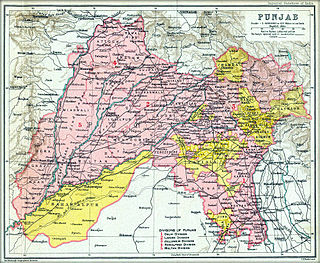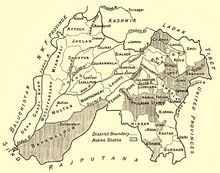
Jindo district is one of the 22 districts of Haryana state in northern India. Jindo town is the administrative headquarters of the district. It is part of Hisar Division and was created in 1966.

British Punjab was a province of British India. Most of the Punjab region was annexed by the British East India Company on 29 March 1849, and declared a province of British rule; it was one of the last areas of the Indian subcontinent to fall under British control. In 1858, the Punjab, along with the rest of British Raj, came under the direct rule of the British Crown. It had a land area of 358,355 square kilometers.
The Hill States of India were princely states lying in the northern border regions of the British Indian Empire.

Patiala district is one of the twenty three districts in the state of Punjab in north-west India.

Kapurthala district is a district of Punjab state in northern India. The city of Kapurthala is the district headquarters.

Multan District, is a district in the province of Punjab, Pakistan. Its capital is the city of Multan. The district has a population of 4.75 million and an area of 3,720 square kilometres. The district consists of tehsils of Multan saddar, Multan city, Jalalpur Pirwala and Shujabad.

East Punjab was a province of India from 1947 until 1950. It consisted parts of the Punjab province that remained in India following the partition of the province between the new dominions of Pakistan and the Indian Union by the Radcliffe Commission in 1947. The mostly Muslim western parts of the old Punjab became Pakistan's West Punjab, later renamed as Punjab Province, while the mostly Hindu and Sikh eastern parts remained with India.

Faridkot district is a district lying in the South-Western part of Punjab, India with Faridkot city as the district headquarters.
Montgomery District was an administrative district of the former Punjab Province of British India, in what is now Pakistan. Named after Sir Robert Montgomery, it lay in the Bari Doab, or the tract between the Sutlej and the Ravi rivers, extending also across the Ravi into the Rechna Doab, which lies between the Ravi and the Chenab. The administrative headquarters was the town of Montgomery, present-day Sahiwal. In 1967, the name of Montgomery District was changed to Sahiwal District.

Kalsia was a princely state in Punjab, British India, one of the former Cis-Sutlej states. It was founded by Gurbaksh Singh Kalsia in 1760. After India's independence, it was included in PEPSU and later in the Indian East Punjab after the States Reorganisation Act, 1956. The area of Kalsia is now located in the modern day Indian states of Punjab and Haryana. In 1940 the population of Kalsia was 67,393. Kalsia was ruled by Jat Sikhs.

Sirmur was an independent kingdom in India, founded in 1616, located in the region that is now the Sirmaur district of Himachal Pradesh. The state was also known as Nahan, after its main city, Nahan. The state ranked predominant amongst the Punjab hill States. It had an area of 4,039 km2 and a revenue of 300,000 rupees in 1891.
Shahpur District was a district in what is now Pakistan from 1893, during the British Raj, till 1960. From 1893 to 1914 Shahpur was the district headquarters. In 1914 the district headquarters were moved from Shahpur to Sargodha, although the district continued to be known as Shahpur. In 1960 the Sargodha District was created and Shahpur District became Shahpur Tehsil.

Nabha State, with its capital at Nabha, was one of the Phulkian princely states of Punjab during the British Raj in India. Nabha was ruled by Jat Sikhs of the Sidhu clan.

Kapurthala State, with its capital at Kapurthala, was a former Princely state of the Punjab Province of India. Ruled by Ahluwalia Sikh rulers, spread across 510 square miles (1,300 km2). According to the 1901 census the state had a population of 314,341 and contained two towns and 167 villages. In 1930, Kapurthala became part of the Punjab States Agency and acceded to the Union of India in 1947.

Jind State was a princely state located in the Punjab region of north-western India. The state was 3,260 km2 (1,260 sq mi) in area and its annual income was Rs.3,000,000 in the 1940s. Jind was founded and ruled by Jat Sikh rulers of Sidhu clan.

Chamba State was one of the oldest princely states in present-day Republic of India, having been founded during the late 6th century. It was part of the States of the Punjab Hills of the Punjab Province in India from 1859 to 1947. Its last ruler signed the instrument of accession to the Indian Union of 15 April 1948.

Patiala State was a self-governing princely state of the Empire of India, and one of the Phulkian States, that acceded to the Union of India upon Indian dominionship and partition. Patiala Kingdom/State was founded by Sidhu Jat Sikhs.

Suket State was one of the Princely states of India during the period of the British Raj. The capital of the state was Pangna. Its last ruler signed the accession to the Indian Union on 15 April 1948. Formerly it belonged to the States of the Punjab Hills and currently, it is part of the Indian state of Himachal Pradesh. The present-day Mandi district was formed with the merger of the two princely states of Mandi and Suket.

The State of Malerkotla or Maler Kotla was established by Maharaja of Parmar Rajputs, is a princely state in the Punjab region since the era of British India. Which was taken over by Sarwani and Lodi Pashtun dynasty from Afghanistan, and named Malerkotla as capital.

Islam is a minority religion in Punjab, India followed by 535,489 people constituting about 1.93 percent of the state population out of 27.7 million population as of 2011 census report.

















